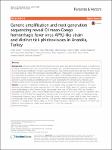Generic amplification and next generation sequencing reveal Crimean-Congo hemorrhagic fever virus AP92-like strain and distinct tick phleboviruses in Anatolia, Turkey
Dinçer, Ender
Brinkmann, Annika
Hekimoğlu, Olcay
Hacıoğlu, Sabri
Földes, Katalin
Karapınar, Zeynep
Polat, Pelin Fatoş
Oğuz, Bekir
Kılınç, Özlem Orunç
Hagedorn, Peter
Özer, Nurdan
Özkul, Aykut
Nitsche, Andreas
Ergünay, Koray
Background: Ticks are involved with the transmission of several viruses with significant health impact. As incidences of tick-borne viral infections are rising, several novel and divergent tick- associated viruses have recently been documented to exist and circulate worldwide. This study was performed as a cross-sectional screening for all major tick-borne viruses in several regions in Turkey. Next generation sequencing (NGS) was employed for virus genome characterization. Ticks were collected at 43 locations in 14 provinces across the Aegean, Thrace, Mediterranean, Black Sea, central, southern and eastern regions of Anatolia during 2014–2016. Following morphological identification, ticks were pooled and analysed via generic nucleic acid amplification of the viruses belonging to the genera Flavivirus, Nairovirus and Phlebovirus of the families Flaviviridae and Bunyaviridae, followed by sequencing and NGS in selected specimens. Results: A total of 814 specimens, comprising 13 tick species, were collected and evaluated in 187 pools. Nairovirus and phlebovirus assays were positive in 6 (3.2%) and 48 (25.6%) pools. All nairovirus sequences were closely-related to the Crimean-Congo hemorrhagic fever virus (CCHFV) strain AP92 and formed a phylogenetically distinct cluster among related strains. Major portions of the CCHFV genomic segments were obtained via NGS. Phlebovirus sequencing revealed several tick-associated virus clades, including previously-characterized Antigone, Lesvos, KarMa and Bole tick viruses, as well as a novel clade. A wider host range for tick-associated virus strains has been observed. NGS provided near-complete sequences of the L genomic segments of Antigone and KarMa clades, as well as Antigone partial S segment. Co- infections of CCHFV and KarMa or novel phlebovirus clades were detected in 2.1% of the specimens. Conclusions: Widespread circulation of various tick-associated phlebovirus clades were documented for the first time in Anatolia. Genomes of CCHFV AP92 strains were identified in previously unexplored locations. NGS provided the most detailed genomic characterization of the Antigone and KarMa viruses to date. The epidemiological and health-related consequences must be elucidated.
No license information

